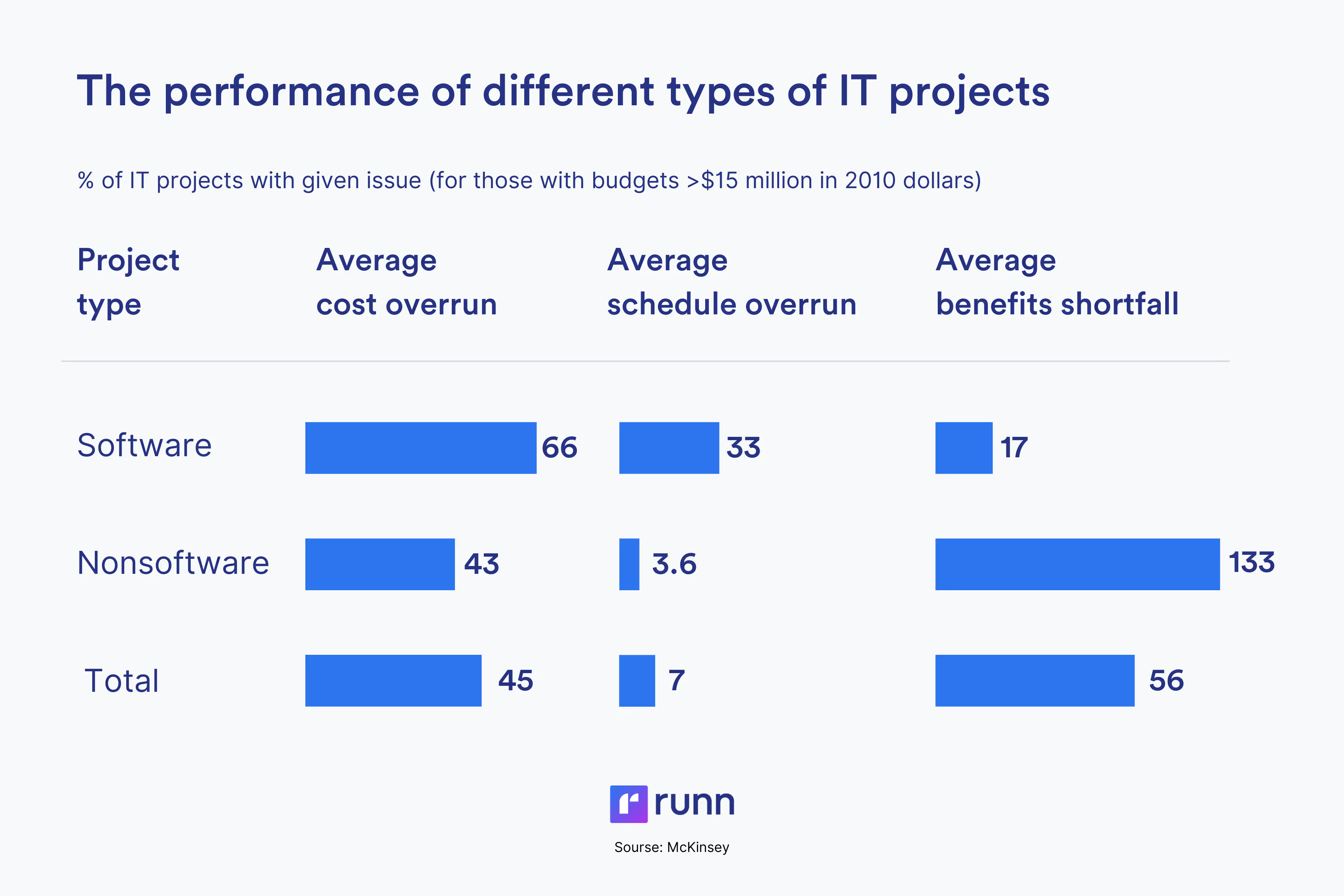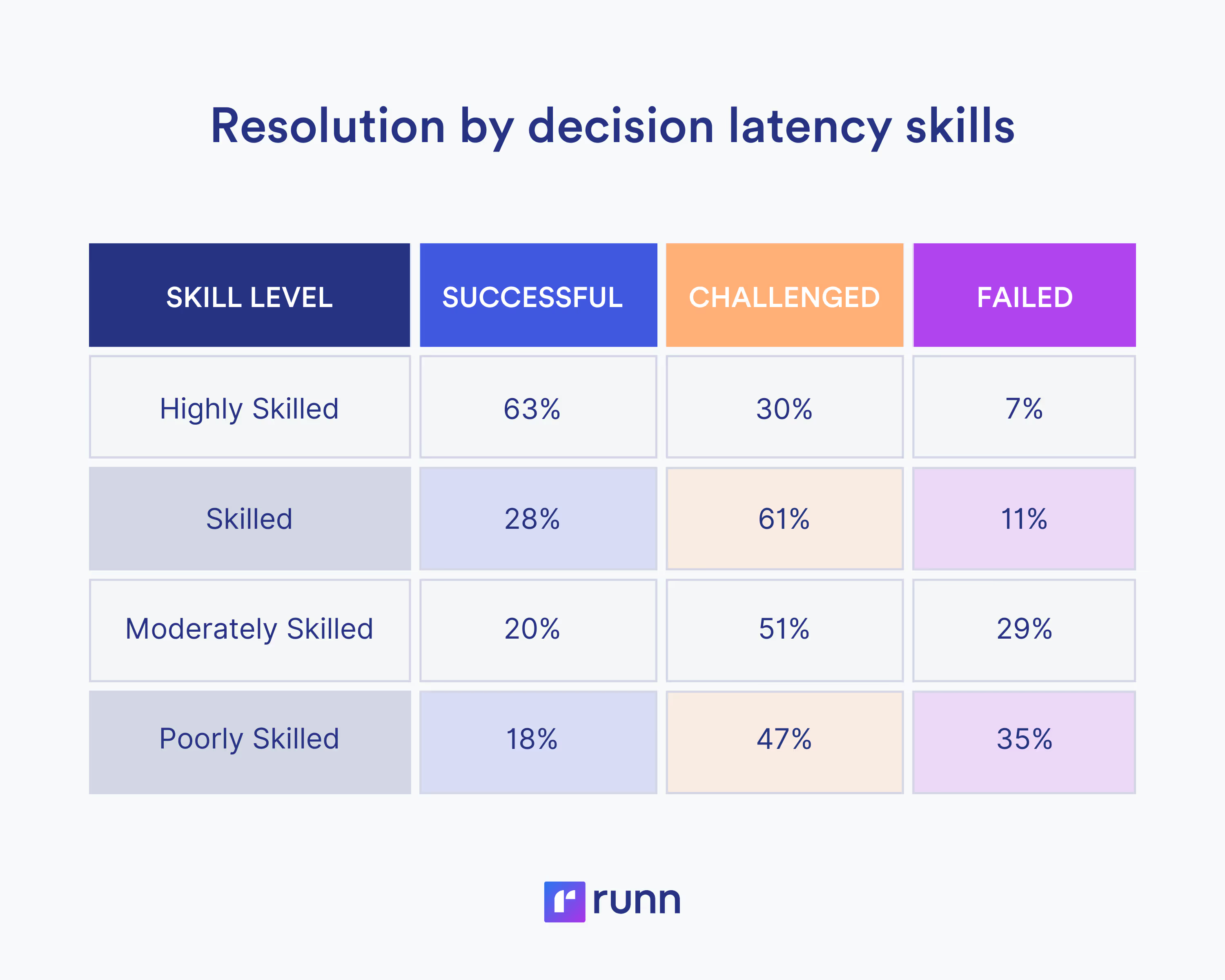Within the broader project management space, managing digital and IT projects presents its own kind of unique challenge - as these IT project management statistics show!

Technology and project management go hand in hand. From the creation of new software to database management, the scope of digital and IT projects is expansive, and professionals must grapple with many obstacles and pitfalls unique to this niche.
To help you better understand the particular quirks and challenges of IT projects, we’ve gathered vital project management statistics, including IT project success data, average project manager salaries, and future predictions.
Covering projects from software development and cloud computing to digital transformation and data management, IT project management plays a pivotal role in most industries and businesses. In fact, while project management is integral to all sectors, 63% of projects in organizations are related to IT.
It’s no surprise that the tech industry is huge – and growing. Let's look at the numbers. Global IT spending is forecast to reach $5.43 trillion in 2025, a 7.9% jump from 2024, with the project management software industry in particular poised for substantial growth, projected to reach about $20.47 billion by 2030.
In terms of which types of IT projects are most popular, IT and digital transformations and new product development projects dominate, with 55% and 46% of all businesses surveyed by APM having undertaken these types of projects in the past year, respectively.
Many teams are embracing hybrid and adaptive project management methodologies that blend Agile flexibility with the structure of traditional frameworks – helping teams stay responsive without losing strategic alignment. According to the Project Management Institute, 31.5% of teams use a hybrid approach.
While hybrid approaches are becoming more mainstream, Agile remains popular with IT managers. Seven in 10 IT departments have adopted agile practices and principles in their organizations, along with 68% of software development and delivery lifecycle teams, according to Digital.ai's State of Agile survey.
KPMG echoes this sentiment, revealing that IT departments take the lead in adopting Agile principles and approaches; in 2019, 50% of respondents were reportedly piloting Agile or adopting agility in their IT department
And Agile has fans in the U.S. government, with 80% of federal IT projects reportedly using Agile project management or iterative approaches.
With investment in digital transformation continuing to accelerate, project management professionals face a new wave of trends reshaping how projects are delivered. The role of AI and predictive analytics in work is a top project management trend.
Tools that once tracked progress are now helping managers forecast risks, model capacity, and optimize resources in real time. This shift supports a broader move toward data-driven, people-first project management – where decisions are informed by live insights into workloads, skills, and team well-being, not just static reports.
WifiTalent’s research into AI in project management found 85% of project managers believe AI has the potential to significantly improve project delivery, while implementation of AI solutions in project management has grown by 45% annually over the last three years.
A 2022 study from the Association for Project Management found that 35% of professionals felt IT projects would likely benefit from AI the most, compared to hospitality, healthcare, marketing, construction, and government.
If you were to ask ten different IT teams what percentage of their projects were successful in 2025, you would get as many different answers. However, one thing seems certain: rates of IT project success are shockingly low.
‘Success’ is dependent on a variety of factors, including adherence to budget, hitting deadlines, and meeting customer expectations.
McKinsey found that, regardless of project size, 59% of all IT projects are completed within budget, 47% are completed on time, and 44% deliver the intended benefits. This sounds good, right? But it isn’t the full story.
Just one in every 200 IT projects meets all three of these measures of success (or 0.5% of all projects), and only one in every 14 is delivered on time and on budget. Projects that fail to meet one or more measures exceeded their budgets by 75%, overran their schedules by 46%, and generated 39% less value than predicted, on average. Yikes.
While most project teams don't experience colossal cost overruns, one in six IT projects looked at in one Harvard Business Review report had a cost overrun of 200%, on average. In one study on project success, the most extreme case saw a project come close to a 700% overrun.
Businesses can run into trouble when their large IT projects – those with budgets over $15 million – fail. McKinsey and the University of Oxford found that, on average, these projects run 45% over budget and 7% over time – yet also deliver 56% less value than predicted.
Plus, the longer a project is scheduled to run, the more likely it'll run over time and budget. Each additional year spent increases cost overruns by 15%.
These risks are not equally balanced across IT project types. Software projects run a higher risk of cost and schedule overruns compared to non-software projects, yet they see an average benefits shortfall of just 17% compared to 133%.
While costly, most businesses can weather these overruns. However, 17% of IT projects perform so poorly that they potentially threaten the company’s future. Known as 'black swans', these large projects can see budget overruns of between 200% and 400%.

Let's look a little deeper at software project failure statistics – because understanding why things break is just as important as knowing how to fix them.
Research from MIT revealed that 95% of organizations are getting zero return on their investments into GenAI, despite $30–40 billion in enterprise investment.
Public-sector IT projects fail more often than private-sector projects, says McKinsey. 81% of public-sector IT projects overrun their schedules compared to 52% of private-sector projects, while public-sector organizations see three times higher cost overruns on average.

Why do so many IT projects fail? Project failure comes down to poor project management. McKinsey and the University of Oxford asked IT executives to identify the cause of their project cost overruns, distributing the 45% of failures as follows:
.avif)
The true impact of IT projects extends far beyond project teams or even their employers. Poor IT project management has the power to impact national economies – positively and negatively.
One estimate reported by Gallup suggests IT project failures represent a loss of $50 billion to $150 billion each year in the United States, while IT project failures cost the European Union €142 billion in 2004 alone.
But it’s not all bad news. Research commissioned by APM estimated that IT project management activities contributed £14.3 billion to the UK economy in 2024.
Looking to start a career in IT project management? Here’s everything you need to know about IT project managers’ wages, popularity, and qualifications.
Over the next decade, tech employment is projected to grow twice as fast as overall employment, while emerging tech and IT project management roles will grow 99% above the national rate.
IT project management is a desirable and competitive career, and there are around 443,211 information technology project managers currently employed in the United States, according to Zippia. In Europe, women occupy only 22% of all tech roles.
When it comes to IT project management salaries, IT project managers earn more on average than those in non-IT roles. The average IT project manager salary is $106,981 in the US, says Zippia, while the average entry-level salary is $76,000.
And in the UK, the average salary of an IT project manager is rising, with an average yearly salary of £48,092.
Looking forward, there’s a significant and growing gap between the number of available jobs and the amount of available talent in the IT project management sector.
According to McKinsey, only 16% of executives feel comfortable with the amount of tech talent they have available to support digital transformation, with 60% of companies saying talent and skills scarcity inhibit transformation. In the EU alone, the tech talent gap will grow to 1.4 million to 3.9 million people by 2027.
This trend suggests there are opportunities for businesses to upskill their people to better meet evolving business needs.
The pressure to get projects over the line can create a culture of overworking; this is known as crunch time. A recent developer satisfaction survey found that 28% of respondents' jobs involved crunch time, while an additional 25% reported their jobs required them to complete periods of long work hours that they didn’t call ‘crunch’. During these periods, 30% of respondents worked more than 60 hours per week
Unsurprisingly, employee productivity is a top business priority for IT projects. Research from Spiceworks suggests that IT professionals feel under pressure to do more than less, with a third of respondents (29%) sharing that this is a top concern for their business. This figure climbs to 41% among IT staff, compared to just 22% of directors and above.
Poor project performance needn't be the norm. By making the following changes to their project management practices, IT teams can make sure they consistently deliver high-performing projects.
Most teams aren’t making the most of their people’s skills. That’s because they aren’t using skills management to their advantage – or enjoying the full benefits of project management.
Our State of Resource Management in 2025 report found that 42% of businesses don’t track skills at all, while over half (53%) of those that do rely on spreadsheets. This means teams are staffing projects based on whoever is free or habit, not who is best suited to the work.

Strategic skills management strengthens teams, reduces project risk, and helps you build a more capable delivery environment.
Take action:
Decision-making has a bigger impact on project success than methodology or team size.
The Standish Group’s latest CHAOS report found high “decision latency” performers achieved a 63% project success rate, compared with just 18% for poorly skilled teams. In other words, fast, confident decisions only happen when teams understand why the work matters.

Clear alignment reduces rework, accelerates prioritization, and helps teams choose the most valuable path when trade-offs arise.
Take action:
Even high-performing teams will struggle to prioritize the right work when dealing with incomplete or outdated information.
The ability to do so relies on access to accurate, up-to-date resource data, something our research uncovered presents a common challenge. Only 10% of resource professionals wholly trust their resource data, while 8% don’t trust their data at all.
.png)
So, why is this such an issue? As 44% of Agile teams still use spreadsheets for strategic planning, and 53% say they can’t use data effectively to support prioritization, it appears outdated tech is holding teams back. You can’t chart a clear path to success based on pure luck.
Take action:
When IT teams can see what’s coming, who’s available, and where constraints exist, they can make smarter choices and keep delivery on track.
Resource management tools like Runn can complement your project management software, bringing people, skills, and project data together in real time, so teams can forecast accurately, resolve conflicts early, and deliver consistently (without burning out their people).